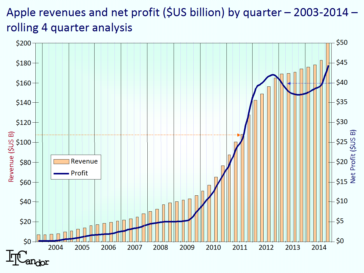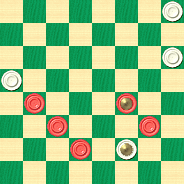The Checker Maven
Jump to navigationNow We Have a Nice Problem

In the chart above, Apple Computer has the "nice problem" of having to figure out what to do with all the money they've made.
"A nice problem to have" is a phrase often heard when someone faces a "dilemma" in which any choice is a good one. Here in Hawai`i, we sometimes have to decide between going to the beach or going to the mall. That's considered a nice problem to have, especially in January.
"A nice problem" in checkers of course means something else, and this week's position, attributed to W. J. Wood, is an example. Mr. Wood himself, after presenting the run-up, stated "Now we have a nice problem." Did he intend a pun or play on words? We rather doubt it.

BLACK
Black to Play and win
B:W29,21,20,K6:B16,K14,11,9,7.
We'll warn you that the solution is very long, but it is also very methodical, and you should be able to work out the general direction if not every detail. There is a trap or two along the way, however, so be careful, and when you've given it a nice try, click your mouse nicely on Read More to see the solution and notes.![]()
Solution
| 1. | 16-19* | 6x13 |
| 2. | 7-10 | 13-17 |
| 3. | 19-23* | 17-22 |
| 4. | 23-27 | 22-26 |
| 5. | 27-31 | 26-22 |
| 6. | 14-9 |
Mr Wood stars this move but in fact 31-27 also wins.
| 6. | ... | 22-18 |
| 7. | 10-15 | |
Mr Wood's solution goes wrong here. He gives 10-14, which only draws after 18-23. However Mr. Wood shows 18-22 for White, which returns to a loss. From here on, of course, we give the computer solution.
| 7. | ... | 18-22 |
| 8. | 31-27 | 21-17 |
| 9. | 27-23 | 29-25 |
| 10. | 9-6 | 17-14 |
| 11. | 15-19 | 25-21 |
| 12. | 19-24 | 21-17 |
| 13. | 24-27 | 17-13 |
| 14. | 27-31 | 14-9 |
| 15. | 6-10 | 9-5 |
| 16. | 11-15 | 20-16 |
| 17. | 23-18 | 22-25 |
| 18. | 10-7 | 5-1 |
| 19. | 18-14 | 1-6 |
| 20. | 7-3 | 6-1 |
| 21. | 15-19 | 16-12 |
| 22. | 3-7 | 1-6 |
| 23. | 7-11 | 6-1 |
| 24. | 19-23 | 1-5 |
| 25. | 23-27 | 25-22 |
| 26. | 27-32 | 5-1 |
| 27. | 32-27 | 1-6 |
| 28. | 27-23 | 6-1 |
The breeches with 22-18 loses to 14-9.
| 29. | 31-27 | 22-25 |
| 30. | 23-18 | 1-6 |
| 31. | 27-23 | 6-1 |
| 32. | 23-26 | 1-6 |
| 33. | 26-22 | 25-21 |
| 34. | 18-15 | 6-1 |
| 35. | 15-10 | 1-5 |
| 36. | 11-7 | 5-1 |
| 37. | 7-3 | 1-5 |
| 38. | 10-7 | 5-1 |
| 39. | 14-10 | 21-17 |
| 40. | 22-18 | 1-5 |
| 41. | 10-14 | 17x10 |
| 42. | 7x14 | 5-1 |
| 43. | 14-10 | 1-5 |
| 44. | 18-15 | 5-9 |
| 45. | 15-11 | 9-5 |
| 46. | 11-7 | 5-9 |
| 47. | 7-2 | 9-5 |
| 48. | 2-6 | 5-9 |
| 49. | 6-1 | 9-6 |
| 50. | 10-14 | 6-2 |
| 51. | 14-18 | 13-9 |
| 52. | 18-14 | |
Black wins.
Black's winning process was to keep most of the White forces bottled up on one side until eventually White ran out of safe moves. The gradual, careful procedure is worthy of study despite its length.
You can email the Webmaster with comments on this article.
